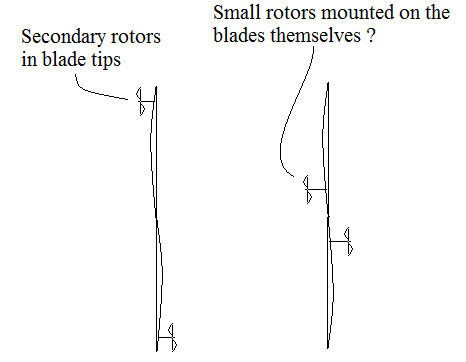This paper reveals the typical beginner’s flawed approach to wind energy based on ignorance and denial of the basics of wind energy. No matter how many formulae are presented, they cannot overcome the ignorance from which the entire approach originates.
The glaring ignorance that jumps out at a person familiar with wind energy starts with two typical beginner errors:
-
believing that surfaces being dragged downwind, entailing a non-power-producing upwind return journey for the working surfaces, is a more effective approach to wind energy. It starts with not even understanding the difference between a lift-based machine, and a drag-based machine, according to long-established wind energy terminology;
-
believing that “this time it’s different” regarding the applicability of the Betz coefficient to a given configuration for a wind energy extraction device.
As to point 1, lift machines versus drag machines, the longstanding convention in wind energy is that “drag-based” operation is exemplified by a Savonius-type device, with the most common example being an anemometer, where cups are pushed downwind by thrust force from the wind, then must fight their way back upwind on the return journey, contributing negative power to the device on this return trip.
It is possible to fly a kite back-and-forth, or in a circle, figure-8, etc., to achieve the a larger amount of downwind thrust, like a larger non-crosswind surface would have. However, if the power is extracted by allowing the working surfaces to travel downwind, with the energy extracted in the downwind direction, from the downwind thrust force, that is still fundamentally a drag-based machine, (that uses lift to achieve greater downwind drag), and it still suffers from the same detractive aspects of any drag-based machine, which is the reduced power from the downwind-traveling surfaces due to reduced relative wind speed impinging on the working surfaces in that downwind direction, plus the power lost on the return trip. It’s the same basic operation as a savonius turbine, as though one is using a parachute dragged downwind, then folded as it returns upwind, which is instantly recognized in the actual art of wind energy as a drag-based machine.
Similarly, in established wind energy, lift is used to pull a blade in a circle against the “drag” of a generator at the center of rotation, however this configuration is called, by long convention, a “lift-based” turbine, and using lift to pull in a circular path against the “drag” of a generator is called “lift mode”, NOT “drag mode”. The lift versus drag naming convention refers to the working surfaces themselves, not the load, which normally induces “drag”.
So just as a start, Loyd and his followers have the entire basis of wind energy backwards, calling lift-based machines “drag”-based, and vice-versa. To jump into wind energy and start reversing the most basic naming conventions just shows an ignorance of how wind energy actually works, and how it has been understood and analyzed for a hundred years, including the naming conventions for the most basic distinctions in types of wind energy extraction approaches.
What is missing is the fact that “lift” has a forward component, and that the tips of wind turbine blades, once traveling, are effective at a zero or even negative setting angle. Watch a hang-glider in flight: the motion is propelled forward, while the wing is angled backwards. Why? There is a vacuum above the front of the wing that pulls it forward. That is called “lift” by long convention, since it results in flight. The fact is a wind turbine blade pulls forward against the “drag” of a generator, on the basis of lift. The same would be true if, as is often discussed but seldom if ever tried, the central generator were replaced by small rotors mounted on the blades themselves. The machine would still be “lift-based”, though perhaps less efficient.
Next, the notion that the Betz coefficient, which is a universal factor, somehow “does not apply” to kite-based or airborne wind energy systems due to the small effect the kite has in such a large area is in error. One could make the same claim for any newbie-inspired first stab at a wind energy device. After all, a typical wind turbine rotor can have a solidity as low as 2%, yet is capable of extracting close to the Betz coefficient. If one were a beginner in wind energy, one might similarly construct a large yet inefficient rotor, incapable of extracting a large percentage of the energy from its swept area, and claim that the Betz coefficient does not apply to it since it does not even approach the betz coefficient anyway. This may be true, but that’s like saying the rules on a racetrack do not apply to a wheelbarrow because it is incapable of winning a race. The fact of a less-effective approach to wind energy does not mean the limits to power extraction don’t apply, just because the given approach does not approach that level of efficiency.
So my opinion is that the two most glaring ignorant mistakes beginners make in wind energy are manifest in this approach to AWE:
- Not even understanding the difference between a lift machine and a drag machine;
- Arguing that the Betz coefficient “does not apply” to ones pet new configuration.
Once that is established, it is easy to see that the understanding of AWE remains at the level of beginners who do not know the ropes or understand the basics of the art to which they aspire.
 - Doug Selsam, June 24, 2020
- Doug Selsam, June 24, 2020
 - Doug Selsam, June 24, 2020
- Doug Selsam, June 24, 2020